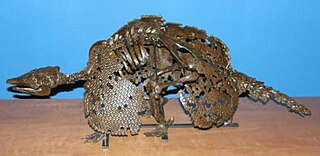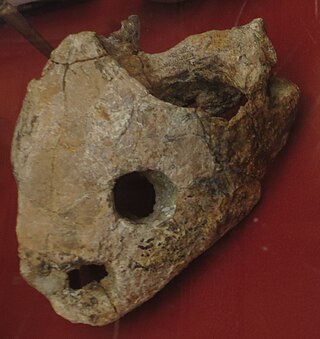Physeter is a genus of toothed whales. There is only one living species in this genus: the sperm whale. Some extremely poorly known fossil species have also been assigned to the same genus including Physeter antiquus from the Pliocene of France, and Physeter vetus from the Quaternary of the U.S. state of Georgia. Physeter vetus is very likely an invalid species, as the few teeth that were used to identify this species appear to be identical to those of another toothed whale, Orycterocetus quadratidens.

Cycloderma is a genus of softshell turtles in the subfamily Cyclanorbinae of the family Trionychidae. The genus is endemic to Africa.

Sinaspideretes is an extinct genus of turtle from the Late Jurassic of China, probably from the Shaximiao Formation. It is considered the earliest and most basal representative of the Trionychia, and is possibly the oldest known member of Cryptodira. In 2013, it was proposed that this animal and the genus Yehguia are in fact one and the same.
Ganorhynchus is an extinct genus of prehistoric lungfish from the Devonian period. Fossils were found in Mansfield, Pennsylvania.
Rhytidosteoidea is a superfamily of Temnospondyli, early amphibian species that existed during the Carboniferous, Permian, and Triassic periods. The taxon was established in 1965 to accommodate two new species of Deltasaurus, the author recognising an alliance with previously described genera.
Brevidorsum is an extinct genus of dissorophoidean euskelian temnospondyl within the family Dissorophidae.
Batrachosuchoides is an extinct genus of prehistoric amphibian from the Early Triassic of Russia. It was found in the Baskunchakskaia Series and the Lestanshorskaya Svita.
Batrachosaurus is an extinct genus of prehistoric brachyopoid amphibian that lived in Germany during the Middle Triassic (Ladinian). The genus was named by Joseph Fitzinger in 1837 and the type species, B. jaegeri, was named three years later in 1840. It may have been the same animal as Mastodonsaurus.
Gosfordia is an extinct genus of prehistoric lungfish known from the Triassic of Australia.

Megapleuron is an extinct genus of prehistoric sarcopterygian or lobe-finned fish that lived during the Asselian age of the Cisuralian epoch in what is now Burgundy, France.

The Scalopinae, or New World moles, are one of three subfamilies of the family Talpidae, which consists of moles and mole-like animals; the other two subfamilies being the Old World talpids and the Chinese shrew-like moles (Uropsilinae). The Scalopinae are the only Talpidae subfamily to consist entirely of undisputed moles and no mole-like close relatives such as shrew-moles or desmans.

Pachyarmatherium is a genus of extinct large armadillo-like cingulates found in North and South America from the Pliocene and Pleistocene epochs, related to the extant armadillos and the extinct pampatheres and glyptodonts. It was present from 4.9 Mya to 11,000 years ago, existing for approximately 4.889 million years.

Chelonoidis is a genus of turtles in the tortoise family erected by Leopold Fitzinger in 1835. They are found in South America and the Galápagos Islands, and formerly had a wide distribution in the West Indies.

Boreostemma is an extinct genus of glyptodonts from northern South America. Fossils assigned to the genus were first described as belonging to Asterostemma from southern South America, but have been placed in the new genus Boreostemma by Carlini et al. in 2008. The type species is B. pliocena. Fossils of Boreostemma have been found in the Honda Group of Colombia, in Peru and Venezuela.
Ilatardia is an extinct genus of bothremydid pleurodiran turtle that was discovered in the Farin Doutchi Formation of Niger. The genus consists solely of type species I. cetiotesta.
Taphrosphys is an extinct genus of bothremydid pleurodiran turtle that was discovered Angola, Morocco and the United States. The genus consists of type species Platemys sulcatus, T. ippolitoi, T. congolensis, and the dubious T. dares.
Phosphatochelys is an extinct genus of bothremydid pleurodiran turtle that was discovered near Oued Zem, Morocco. The genus consists solely of type species P. tedfordi.
Labrostochelys is an extinct genus of bothremydid pleurodiran turtle that was discovered in the Ouled Abdoun Basin, Morocco. The genus consists solely of type species L. galkini.

Nigeremys is an extinct genus of bothremydid pleurodiran turtle from Niger, Mali and Syria. The genus consists exclusively of the combinatio nova of the type species N. gigantea.

Sphodrosaurus is an extinct genus of basal archosauriform reptiles from the Late Triassic-aged New Oxford Formation of Pennsylvania. The type species is S. pennsylvanicus, described by Edwin Colbert in 1960. The holotype consists of a partial skeleton including the back of the skull, the vertebral column, all of the ribs, all of the hindlimbs and part of the upper forelimbs; Sphodrosaurus was originally believed to have been a member of the Procolophonidae while more recently Sphodrosaurus was believed to be a basal member of the Diapsida by most authors starting with Sues et al. (1993), or a member of the Rhynchosauria. In 2022, Ezcurra & Sues redescribed the holotype in detail and placed it in a phylogenetic analysis with other Triassic diapsid reptiles, where it was found as the basalmost doswellid.









